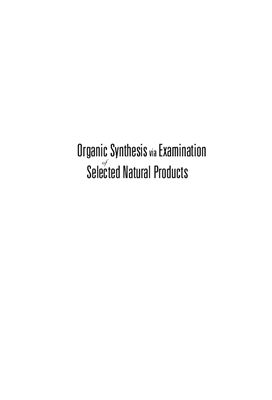World Scientific Publishing Co. 2011. 566 p.
This book is written for advanced graduate and undergraduate students to expose them to a variety of strategies for the synthesis of organic compounds. This is done largely within the context of natural products synthesis, but some unnatural products synthesis is also included. Multiple approaches to each group of synthesis targets are presented, and the approaches are compared with one another with an eye on similarities and differences. General problems in organic synthesis (for example, strategies for the preparation of 6-membered rings and 5-membered rings, the importance of oxidation state, the problem of acyclic diastereoselectivity, the problem of controlling absolute stereochemistry, the importance of functional group relationships) are introduced early in the book and revisited throughout the text within the context of a variety of structurally unrelated natural products.
The book provides readers with a somewhat historical overview of organic and natural products chemistry, and spans synthetic methodology that dates from the 1940's to the present time. It is written in a style that readers will find entertaining at times. It also contains lots of useful references with complete titles provided.
Contents
Introduction
Steroids
Prostaglandins
Pyrrolizidine Alkaloids
Juvabione and the Vicinal Stereochemistry Problem
Functional Group Reactivity Pattes and Difunctional Relationships
Some Unnatural Products — Twistane and Triquinacene
Alkaloids — Difunctional Relationships and the Importance of the Mannich Reaction
Alkaloids from Dart-Poison Frogs
Morphine and Oxidative Phenolic Coupling
Olefin Synthesis and Cecropia Juvenile Hormone
A Recent Example of Structure Determination Through Total Synthesis and Convergent Syntheses: Lasonolide A
Ionophores: Calcimycin
Erythromycin A Aglycone
This book is written for advanced graduate and undergraduate students to expose them to a variety of strategies for the synthesis of organic compounds. This is done largely within the context of natural products synthesis, but some unnatural products synthesis is also included. Multiple approaches to each group of synthesis targets are presented, and the approaches are compared with one another with an eye on similarities and differences. General problems in organic synthesis (for example, strategies for the preparation of 6-membered rings and 5-membered rings, the importance of oxidation state, the problem of acyclic diastereoselectivity, the problem of controlling absolute stereochemistry, the importance of functional group relationships) are introduced early in the book and revisited throughout the text within the context of a variety of structurally unrelated natural products.
The book provides readers with a somewhat historical overview of organic and natural products chemistry, and spans synthetic methodology that dates from the 1940's to the present time. It is written in a style that readers will find entertaining at times. It also contains lots of useful references with complete titles provided.
Contents
Introduction
Steroids
Prostaglandins
Pyrrolizidine Alkaloids
Juvabione and the Vicinal Stereochemistry Problem
Functional Group Reactivity Pattes and Difunctional Relationships
Some Unnatural Products — Twistane and Triquinacene
Alkaloids — Difunctional Relationships and the Importance of the Mannich Reaction
Alkaloids from Dart-Poison Frogs
Morphine and Oxidative Phenolic Coupling
Olefin Synthesis and Cecropia Juvenile Hormone
A Recent Example of Structure Determination Through Total Synthesis and Convergent Syntheses: Lasonolide A
Ionophores: Calcimycin
Erythromycin A Aglycone

